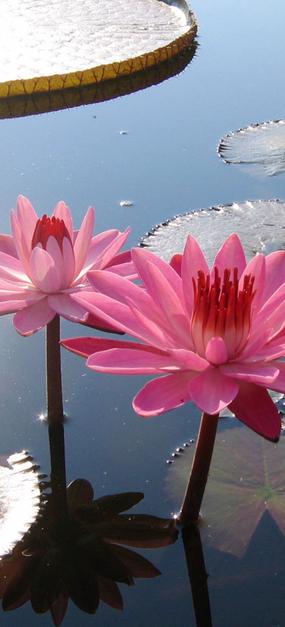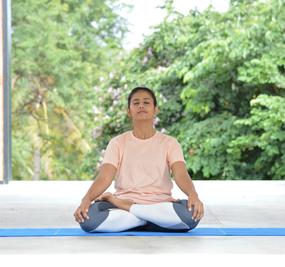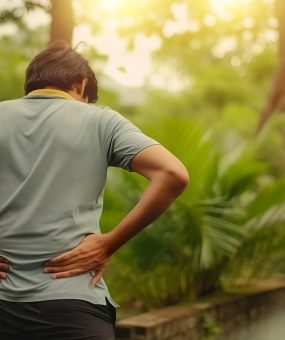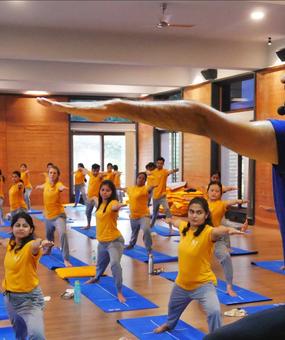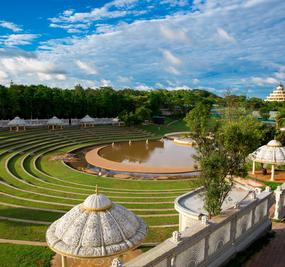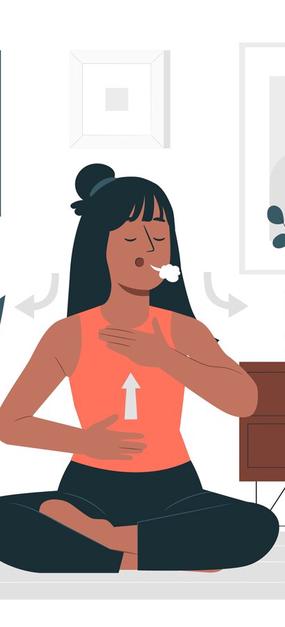Consider the ancient art of pottery, where skilled hands mold clay into vessels of beauty and purpose. Just as the potter shapes clay, Padma Sadhana shapes our inner landscape, molding us into vessels of strength and resilience. Crafted by Gurudev Sri Sri Ravi Shankar, this transformative yoga practice invites us to surrender to the process of self-refinement, allowing us to emerge as vessels of peace, wisdom, and love.
In the world of yoga, Padma Sadhana stands out as something special. Let’s journey together into the heart of Padma Sadhana to discover why it’s so important. Padma Sadhana is a sequence of yoga postures, the Nadi Shodhan breathing technique (pranayama), and meditation. It is a sadhana that leads one to get a glimpse of oneself.
Let’s explore these poses
we’ll learn how they can help us feel better in many ways. While exploring the scientific benefits of these yoga poses, it’s important to note that we’re not delving into the intricacies of performing them perfectly. For precise guidance on practicing these asanas and becoming competent enough to teach others, I recommend reaching out to Sri Sri School of Yoga. Their expert instructors can provide comprehensive training, ensuring you learn how to perform each asana correctly and safely. Through their guidance, you’ll not only deepen your practice but also acquire the skills to share the transformative power of yoga with others.
Body Rotation
This asana, especially when performed passively, shifts autonomic nerve activity towards a parasympathetic-dominant state, promoting relaxation and reducing stress. The twisting motion engages the spine, improving mobility and enhancing circulation. This aids in maintaining spinal health and overall well-being. Performing body rotations while sitting in Lotus or half Lotus posture can enhance flexibility, strength, and overall well-being. Autonomic nerve activity shifts to a parasympathetic nerve-dominant state through passive static stretching, and the effect continues for at least five minutes after completion. In normal parlance, this implies the promotion of a deep relaxation state. (Source: 2, 4 )
Half-Locust Asana (Ardha Shalabhasana)
‘Shalabha’ is a Sanskrit term that means ‘grasshopper’ or ‘locust’. In this asana, a person’s legs resemble the shape of a locust. This asana benefits lower back pain, gastrointestinal issues, urogenital health, and the endocrine system. The isometric nature of this pose improves cardiovascular health by holding muscle tension while encouraging mobility and easing pressure on joints. (Source: 1, 2, 4 )
Full-Locust Asana (Purna Shalabhasana)
Lifting both legs simultaneously in this pose can strengthen muscles, improve endurance, and potentially prevent conditions like osteoporosis. These poses harness the power of synovial rotation to engage and stretch core muscles. By lifting both legs simultaneously, practitioners activate synovial joints, facilitating twisting motions that enhance flexibility and strength. The lumbar and cervical regions play crucial roles in these poses, allowing for controlled movement and deep stretching. As the spine twists, the abdominal organs receive increased blood flow, promoting digestive health and overall well-being. (Source 1, 2 )
Cobra Asana (Bhujangasana)
This posture aids in reducing back pain, enhancing spinal flexibility, and promoting relaxation. It stretches the chest, abdomen, and shoulders while strengthening the spine and buttocks muscles. Cobra pose also stimulates abdominal organs, improving digestion and alleviating constipation. cobra pose specifically targets the chest region, allowing for deep backbends that open the chest and stimulate abdominal organs. Bow pose focuses on holding the feet while lifting the body; it activates synovial joints and promotes blood flow around the navel, benefiting digestive health and overall vitality. (Sources: 1, 2, 4 )
Superman Asana (Viprita Sulbhasana)
By lifting arms and legs while keeping the stomach on the floor, this pose strengthens core muscles and improves body alignment. It targets the muscles of the back, shoulders, and glutes; enhancing spinal stability reduces the risk of back injuries. Superman’s pose also helps improve posture and promotes a strong mind-body connection. (Source 4 )
Bow Asana (Dhanurasana)
Holding this pose with hands holding feet strengthens back muscles; improves posture; stimulates abdominal organs; stretches the entire front of the body, including the chest, abdomen, and thighs; strengthens back muscles; improves spinal flexibility; aids in relieving stress fatigue; and promotes overall well-being. Incorporate synovial rotation to stretch and strengthen core muscle. By bending backward, practitioners engage synovial joints in lumbar cervical regions, improving spinal flexibility and circulation. ( Source: 1, 2, 4 )
Crocodile Asana (Makarasana)
With its focus on stretching and engaging core muscles, the Crocodile pose aligns with the findings that stretching promotes flexibility and muscle engagement. This engagement helps stabilize the spine and improve balance, which is crucial for maintaining a healthy posture and preventing injuries. Additionally, gentle stretching releases tension in muscles, improving blood circulation and promoting normal digestion. (Source: 1, 4 )
Boat Asana (Naukasan)
Boat pose strengthens abdominal muscles, hip flexors, and the spine, improving posture stability. This weight-bearing asana helps prevent osteoporosis, reduces back pain, and promotes improved posture and musculoskeletal health. (Sources: 1, 2 )
Alternate Knees Press (Ardh Pawan Mukt Asana) & Full Knees Press ( Purna Pawan Mukt Asana)
They encourage proper alignment and posture, reducing back pain and improving musculoskeletal health. It helps relieve trapped air by relaxing the stomach and colon. The increased range of motion resulting from prolonged stretching is most likely due to an increase in the length of both connective muscle tissues. Increased connective tissue length can occur due to the property of plastic elongation; increased muscle length can occur through the addition of sarcomeres ends of muscle fibers. (Sources: 2, 3, 4 )
Shoulder-stand Asana (Sarvangasana)
Shoulder-stand pose stretches strengthen core muscles, improve circulation, and support bone health. The cervical region enables flexion, extension, and twisting, promoting blood flow and rejuvenating tissues. (Sources: 4, 2 )
Dancing Shiva Asana (Natraj Asana)
By practicing this pose, one can enhance balance, flexibility, and strength gently.
Dead Body Asana (Shavasan)
This relaxation pose gently stretches core muscles while promoting mental calmness and relaxation. It improves blood circulation, aiding in normal digestion and overall cardiovascular health. (Source: 4 )
Spinal-twist Asana (Ardha Matsyendrasana Asana):
Spinal-twist pose enhances mobility, releases muscle tension, improves blood flow to the abdominal organs, promotes digestion, and relieves stress. Spinal-twist Asana targets lumbar cervical regions, releasing tension in muscles and enhancing flexibility. As the body twists, the abdominal muscles are stretched and compressed alternately, promoting digestion and relieving stress. (Sources: 4,2 )
Mountain Asana (Parvat Asan) & Yoga-Mudra
These poses aid in strengthening the cardiovascular system, improving digestion, reducing stress levels, and enhancing overall health. (Source: 4 )
Nadi Shodhan Pranayama
Nadi Shodhana Pranayama regulates breathing and calms the mind through olfactory nerve activation. This relaxes the hypothalamus, which regulates the stress response and hormonal balance. It restores harmony to the body’s natural balance by breathing rhythmically, stabilizing the HPA axis. ( Source:7 )
Meditation
Deep meditation is a normal outcome post-performance of the asanas within padmasadhana. A glimpse of the inner self, a flush of energy, positivity, and an inner smile are outcomes of the padma sadhana.
Asanas are performed concurrently with the Ujjayi breath, thus allowing the flow of the breath to be deep and long, allowing more oxygen to enter the body
In the Agama tradition, the goddess is depicted seated on a special seat made of five layers. Each layer represents an important quality: stability (tortoise), awareness (snake), grace (lion), perfection (siddha), and full blossoming (lotus). When we practice with these qualities in mind, it is called Padma Sadhana. This practice helps us connect with the divine within ourselves. ( Source: 6 )
As we conclude this exploration into the transformative journey of Padma Sadhana, it becomes evident that by immersing ourselves in sacred practice with dedication and consistency, we unlock inner energy potential, leading to profound shifts at physical, mental, and spiritual levels. For those seeking to deepen their understanding of the Padma Sadhana, attending the Yoga Teacher Training Program (TTP) can provide invaluable insights and guidance.
References
- https://www.yogajournal.com/practice/core-work-yoga-poses/
- https://www.researchgate.net/profile/Manoj-Jagtap-2/publication/331430385_Fertilization_to_Implantation’_Described_By_Sushruta_A_Literature_Study/links/5c78c3ed458515831f782f14/Fertilization-to-Implantation-Described-By-Sushruta-A-Literature-Study.pdf#page=9
- https://onlinelibrary.wiley.com/doi/full/10.1111/j.1520-037X.2001.00542.x#b35
- https://www.researchgate.net/profile/Priyanka-Verma-64/publication/370344337_THE_THERAPEUTIC_ASPECT_OF_ASANA’S_FIRST_EDITION/links/644bbcc497449a0e1a642581/THE-THERAPEUTIC-ASPECT-OF-ASANAS-FIRST-EDITION.pdf
- https://www.betterhealth.vic.gov.au/yoga-health-benefits
- https://www.artofliving.org/in-en/yoga/yoga-poses/how-to-do-padma-sadhana
- https://www.sciencedirect.com/science/article/pii/S0975947623000906



